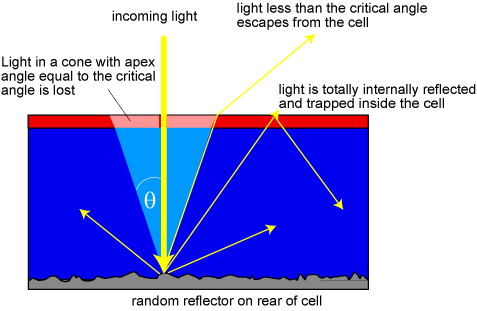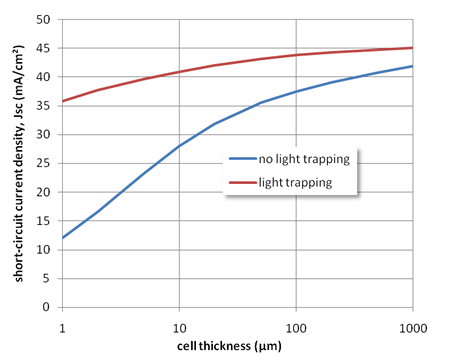A Lambertian back reflector is a special type of rear reflector which randomizes the direction of the reflected light. High reflection off the rear cell surface reduces absorption in the rear cell contacts or transmission from the rear, allowing the light to bounce back into the cell for possible absorption. Randomising the direction of light allows much of the reflected light to be totally internally reflected. Light reaching the top surface at an angle greater than the critical angle for total internal reflection is reflected again towards the back surface. Light absorption can be dramatically increased in this way, since the pathlength of the incident light can be enhanced by a factor up to 4n2 where n is the index of refraction for the semiconductor 1. This allows an optical path length of approximately 50 times the physical devices thickness and thus is an effective light trapping scheme. A Lambertian rear surface is illustrated in the figure below.

Light trapping using a randomised reflector on the rear of the cell. Light less than the critical angle escapes the cell but light greater than the critical angle is totally internally reflected inside the cell. In actual devices, the front surface is also textured using schemes such as the random pyramids mentioned earlier.
The graph below shows the short-circuit current of a silicon solar cell with and without light trapping. In the case without light trapping, the light makes only one pass through the solar cell with some of the light (particularly in the infrared) passing straight through the cell without being absorbed. In the case with ideal light trapping the path length is increased by 4n2 (4 × 3.52 ≈ 50) and the short-circuit current is much higher. In practice the level of light trapping is somewhere between these two limits.

Light trapping increases the short-circuit current (JSC) of the solar cell - particularly for thin devices.
- 1. , «Intensity Enhancement in Textured Optical Sheets for Solar Cells», IEEE Transactions on Electron Devices, т. ED-29, с. 300-305, 1982.
